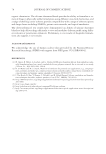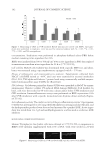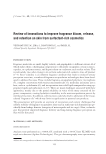JOURNAL OF COSMETIC SCIENCE 112 In a same manner, sebum production was evaluated with the Sebumeter® technology. With this photometric device, the total mass of lipids excreted by surface unit (in μg/cm²) can be quantifi ed by refl ectometry (Figure 5). At D15, there was a signifi cant (p 0.0001) decrease in sebum production on treated scalp by -58% compared to baseline (D0). The decrease in sebum production was continuous until the end of the study to reach a fi nal -67% (p 0.0001) compared to baseline (D0). Visual improvement of the scalp, both for quantity of fl akes and sebum production, was clearly noticeable, as shown by macrophotography (Figure 6). Photos of scalp taken at D0 D3 and D30 on volunteer 20 displayed less adherent fl akes on hair and scalp, and less greasy appearance at the end of the study (D30) before treatment (D0). CONCLUSION The study reported here identifi es E. angustifolium extract as an effi cient antidandruff and antisebum cosmetic active ingredient targeting the three main characteristics of the skin disorder (sebum production, SC disruption, and skin infl ammation). We propose that one important molecular mechanism underlying E. angustifolium extract effi cacy involves nor- malization of defensins (hBD2 and hBD3) and TLR2 expression to limit infl ammatory skin response to Malassezia infection. To our knowledge, this is the fi rst time that an antidandruff active is associated with immunomodulation of the skin response to Malas- sezia invasion. REFERENCES (1) C. Pierard-Franchimont, E. Xhaufl aire-Uhoda, and G. E. Pierard, Revisiting dandruff, Int. J. Cosmet. Sci., 28(5), 311–318 (2006). (2) J. R. Schwartz, A. G. Messenger , A. Tosti, G. Todd, M. Hordinsky, R. J. Hay, X. Wang, C. Zachariae, K. M. Kerr, J. P. Henry, R. C. Rust, and M. K. Robinson, A comprehensive pathophysiology of dandruff and seborrheic dermatitis - towards a more precise defi nition of scalp health, Acta. Derm. Venereol., 93(2), 131–137 (2013). (3) J. R. Schwartz, C. M. Cardin, and T. L. Dawson Jr., “Dandruff and Seborrheic Dermatitis,” in Textbook of Cosmetic Dermatology, 3rd Ed., R. Baran and H. I. Maibach. Eds. (CRC Press, London, New York, 2004), pp. 259–272. Figure 6. Epilobium angustifolium extract improves scalp appearance.
BATTLE AGAINST DANDRUFF 113 (4) R. Hay, Malassezia, dandruff and seborrhoeic dermatitis: An overview, Br. J. Dermatol., 165(S2), 2–8 (2011). (5) Y. M. DeAngelis, C. M. Gemmer, J. R. Kaczvinsky, D. C. Kenneally, J. R. Schwartz, and T. L. Dawson Jr, Three etiologic facets of dandruff and seborrheic dermatitis: Malassezia fungi, sebaceous lipids, and individual sensitivity, J. Investig. Dermatol. Symp. Proc., 10(3), 295–297 (2005). (6) B. I. Ro and T. L. Dawson, The role of sebaceous gland activity and scalp microfl oral metabolism in the etiology of seborrheic dermatitis and dandruff, J. Investig. Dermatol. Symp. Proc., 10(3), 194–197 (2005). (7) G. Gaitanis, A. Velegraki, P. Mayser, and I. D. Bassukas, Skin diseases associated with Malassezia yeasts: Facts and controversies, Clin. Dermatol., 31(4), 455–463 (2013). (8) G. K. Kim, Seborrheic dermatitis and Malassezia species: How are they related? J. Clin. Aesthet. Derma- tol., 2(11), 14–17 (2009). (9) M. Zareei, A. Mohammadi, B. B. Zeinab, and J. H. Seyed, Frequency of different Malassezia species in scalp dandruff. Infect. Epidemiol. Med., 2(2), 22–25 (2016). (10) T. L. Dawson Jr., Malassezia globosa and restricta: breakthrough understanding of the etiology and treatment of dandruff and seborrheic dermatitis through whole-genome analysis, J. Investig. Dermatol. Symp. Proc., 12(2), 15–19 (2007). (11) T. Nakatsuji, M. C. Kao, L. Zhang, C. C. Zouboulis, R. L. Gallo, and C. M. Huang, Sebum free fatty acids enhance the innate immune defense of human sebocytes by upregulating beta-defensin-2 expres- sion, J. Invest. Dermatol., 130(4), 985–994 (2010). (12) G. Donnarumma, I. Paoletti, E. Buommino, M. Orlando, M.A. Tufano, and A. Baroni, Malassezia furfur induces the expression of beta-defensin-2 in human keratinocytes in a protein kinase C-dependent manner, Arch. Dermatol. Res., 295(11), 474–481 (2004). (13) A. Baroni, M. Orlando, G. Donnarumma, P. Farro, M. R. Iovene, M. A. Tufano, and E. Buommino, Toll-like receptor 2 (TLR2) mediates intracellular signalling in human keratinocytes in response to Malassezia furfur, Arch. Dermatol. Res., 297(7), 280–288 (2006). (14) G. A. Turner, M. Hoptroff, and C. R. Harding, Stratum corneum dysfunction in dandruff, Int. J. Cosmet. Sci., 34(4), 298–306 (2012). (15) R. A. Bacon, H. Mizoguchi, and J. R. Schwartz, Assessing therapeutic effectiveness of scalp treatments for dandruff and seborrheic dermatitis, part 2: The impact of gender and ethnicity on effi cacy, J. Derma- tol. Treat., 25(3), 237–240 (2014).
Purchased for the exclusive use of nofirst nolast (unknown) From: SCC Media Library & Resource Center (library.scconline.org)












































































































































